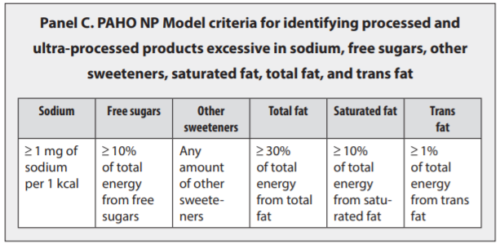The Pan-American Health Organization (PAHO) has developed a Nutrient Profile Model, which it describes as “a tool to classify processed and ultra-processed food and drink products that are in excess of critical nutrients such as sugars, sodium, total fat, saturated fat and trans-fatty acids.”
To understand how it works, go to the website. Watch the video.
Its purpose, as explained in the print publication is to help governments to identify unhealthy products and use public policies to discourage the consumption of those products.
The Expert Consultation Group described in this report was commissioned to develop a Nutrient Profile Model for the Pan American Health Organization – the PAHO NP Model – to be used as a tool in
the design and implementation of various regulatory strategies related to the prevention and control of obesity/overweight, including the following:
• Restriction in the marketing of unhealthy food and beverages to children
• Regulation of school food environments (feeding programs and food and beverages sold in schools)
• Use of front-of-package (FOP) warning labels
• Definition of taxation policies to limit consumption of unhealthy food
• Assessment of agricultural subsidies
• Identification of foods to be provided by social programs to vulnerable groups.
The criteria for ultra-processed foods to be avoided or eaten in small amounts:

It’s a start.
PAHO produces its Nutrient Profile Tool in Spanish, of course: Perfil de Nutrientes – OPS/OMS | Organización Panamericana de la Salud (paho.org)a
It also has a report listing ultra-processed foods in Latin America, and many other useful documents.
As for me, I rather like the broader definition of ultra-processed foods described by the Brazilian public health academics who defined the term:
A practical way to identify an ultra-processed product is to check to see if its list of ingredients contain…either food substances never or rarely used in kitchens (such as high-fructose corn syrup, hydrogenated or interesterified oils, and hydrolysed proteins), or classes of additives designed to make the final product palatable or more appealing (such as flavours, flavour enhancers, colours, emulsifiers, emulsifying salts, sweeteners, thickeners, and anti-foaming, bulking, carbonating, foaming, gelling and glazing agents).
All of these are great resources for food policy in Latin America.
Let’s hope governments respond.



